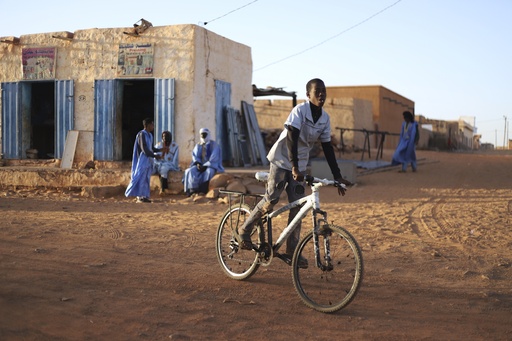
CHINGUETTI, Mauritania — For many generations, Chinguetti has been a vibrant gathering place for poets, scholars, and theologians, known for its rich history as a trans-Saharan trading hub. The city is home to an impressive collection of more than a dozen libraries containing thousands of ancient manuscripts. However, this historic site is now facing a dire threat as encroaching desert sands begin to overwhelm it. The once-thriving city, founded in the 8th century, is rapidly being buried beneath dunes that residents fear may ultimately consume it.
As climate change continues to intensify, the region is experiencing hotter and drier conditions, leading to an increase in sandstorms that dump significant amounts of sand onto Chinguetti’s streets and residences. In some cases, entire homes are becoming submerged. While tree-planting initiatives are underway to combat the advancing sands, they have thus far failed to alleviate the community’s deep-seated anxieties about what the future holds.
Chinguetti is recognized as one of four UNESCO World Heritage sites in Mauritania, a country in West Africa where only half a percent of land is suitable for agriculture. According to World Bank data, Africa, which is the least contributing continent to global fossil fuel emissions, has only witnessed worse climate impacts in Somalia and Eswatini.
The locals regard Chinguetti as one of Islam’s sacred cities, with its structures made of dry stone and mud mortar housing some of West Africa’s oldest Quranic texts. The manuscripts, covering diverse areas such as law and mathematics, represent centuries of scholarship and culture. Community leader Melainine Med El Wely expresses a profound anguish as he watches the city’s fate unfold, describing it as akin to witnessing a natural disaster in slow motion.
“It’s as if this city is being engulfed by an ever-advancing ocean of sand,” says El Wely, who heads the local Association for Participatory Oasis Management. He reflects on how he has seen places he once knew as homes now entirely buried. In a memorable incident, a camel wandered into a neighborhood only to fall into what used to be someone’s living room after a sandstorm had covered it.
Research indicates that sand migration significantly contributes to desertification, causing deserts like the Sahara to expand rapidly and transforming once-vegetated areas into barren landscapes. Earth scientist Andreas Baas from King’s College London notes that scenarios previously thought to be remote are becoming more plausible, signaling an urgent need for action.
With over 75 percent of the planet’s land experiencing dryness in recent decades, plants, animals, and humans face severe survival challenges due to the diminishing moisture in various regions. The resulting conditions lead to crop failures, sandstorms, and wildfires, exacerbated by climate change. A recent U.N. report identifies human-induced climate change as the primary driver behind these changes, causing increased aridity and resulting in health crises and large-scale migrations globally.
Although the focus of scientists and policymakers often veers toward degraded fertile areas, Chinguetti serves as a living example of the consequences of changing climate, experiencing dwindling water supplies and vanishing livelihoods. Local date farmer Salima Ould Salem, aged 50, struggles to sustain his palm trees, relying on water transported from tanks and adapting his agricultural practices. The sand now blocks the entrance to his home and has buried former residences of numerous neighbors. Nearby, a once-promising guesthouse built by a Belgian investor is now largely submerged in a sea of shifting sand.
Despite many in his community relocating to escape the desert’s advance, Salem chooses to stay, fully aware that every departure reduces the community’s strength and increases vulnerability to encroachment. “If I leave, my place will disappear,” he reflects.
The once-vibrant greenery of acacia, gum, and palm trees that provided a buffer against sand has largely disappeared, either due to drought or being cut down for fuel. Although sandstorms have always occurred, they have become increasingly frequent and intrusive, with residents now using mules and carts to remove accumulating sand because bulldozers cannot navigate the historically narrow streets. As a solution, Bahane suggests planting more trees in both urban and surrounding areas to create “green belts.” This idea aligns with ambitious continental projects like Africa’s “Great Green Wall” aimed at environmental restoration.
While some efforts to replant trees are underway, they have yet to significantly halt the encroaching sand. It often takes years for newly planted trees to grow deep taproots capable of reaching groundwater. “We are resigned to the belief that desertification is our fate, but thankfully, there are still those who believe in resisting it,” El Wely asserts, emphasizing the need for continued efforts to preserve this vital piece of history and culture.

